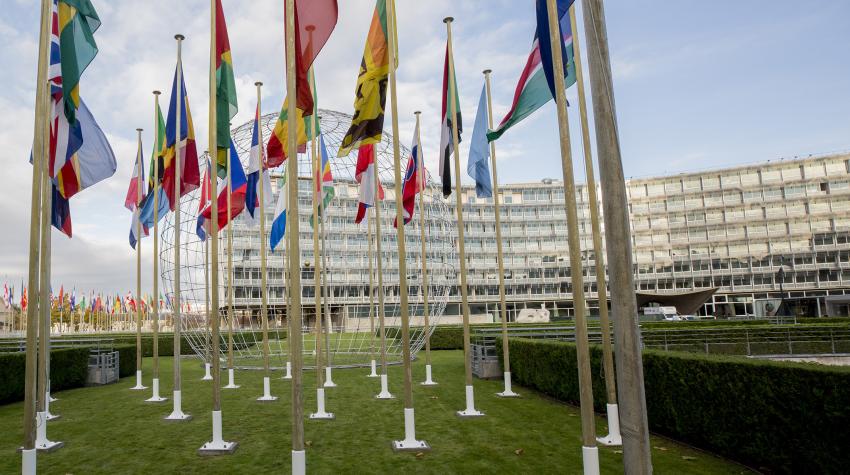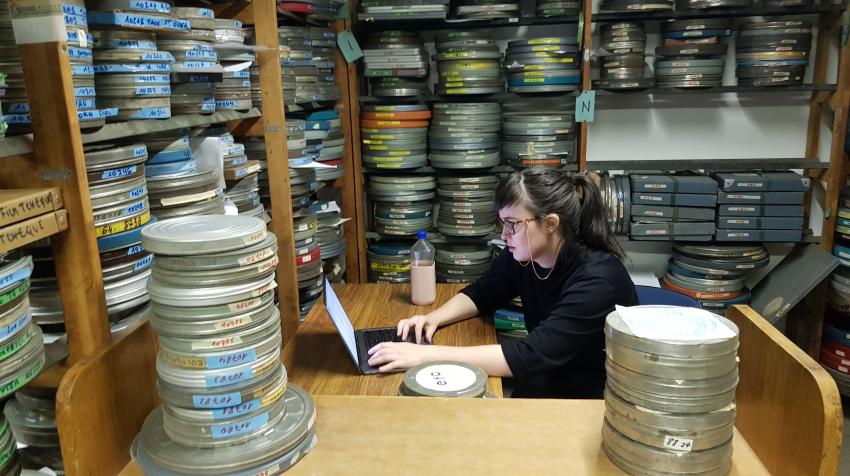25 October 2023
In a scene from Ariel Nasr’s 2019 documentary The Forbidden Reel, Ibrahim Arify, a former president of Afghan Film, the State film archives, flips through colour photographs of a nondescript building complex. “The whole place was like this, with birds’ nests'', he says, pointing to a photo of a drab hallway with large, damaged areas on a turquoise-coloured wall. “These are little birds that nest in abandoned places.” The film recounts how, in 1996, part of the Afghan film archives was saved by employees who hid films from the Taliban behind a false wall. “Bring out all the films, and if a single film is hidden, it will cost you your life”, they were told. The Taliban burned all the films the employees could not hide. The remarkable fact in this story is that ordinary people risked their lives to preserve a body of films, what they considered to be their national film heritage.
The death-defying act of the Afghan Film employees is one example—albeit an extraordinary one—of just how powerful and meaningful films can be, and how a body of films might represent a “film heritage” with a profound impact on cultural, national or institutional identities and histories. From a conservation perspective, the detail about the birds nesting in the archives is an extreme instance of a familiar phenomenon: archives are subject to many types of threats to their well-being and long-term survival, including neglect, physical deterioration and political conflict, among other factors. Films and audio recordings are vulnerable in particular ways. They need to be kept in temperature- and humidity-controlled environments, and unlike paper archives, they rely on the intermediary of special equipment to be seen and heard.
This year’s theme for the World Day for Audiovisual Heritage (27 October 2023), “Your Window to the World”, alludes to the remarkable qualities of audiovisual records. Moving images in particular can resonate in ways that perhaps no other recorded media can. From their earliest days, the United Nations and the United Nations Educational, Scientific and Cultural Organization (UNESCO) recognized film as a powerful medium for communication and education. UNESCO, with part of its mandate focused on the preservation of cultural heritage and another part on what it called “mass communication”—the potential of forms such as radio, television, press and film to reach mass audiences—used media not only to operationalize many of its programmes but also concerned itself at an early stage with the conservation of audiovisual heritage. One can see the integration of these concerns in the establishment, in 2006, of the World Day for Audiovisual Heritage, commemorating the adoption of the 1980 UNESCO Recommendation for the Safeguarding and Preservation of Moving Images. Well before then, in 1952, UNESCO organized an International Conference of Artists during the twenty-sixth Venice Biennale. One outcome of the Conference was a draft resolution published by the Film Committee that is as relevant today as then: “The Conference, recognizing the value of the cinema as an art, and the historical value of films of the past… many of which have unfortunately been lost to posterity, or are in danger of being lost, urges all governments… to make due provision for the establishment of national film archives”.
The United Nations, for its part, not long after its establishment, formed a dedicated body for film, the United Nations Film Board (UNFB), by 1947. In 1949, UNFB produced a suite of documentary films, including the Academy Award-winning First Steps, which follows disabled children as they swim, play music, make art, eat and exercise as part of occupational and physical therapy. UNESCO worked with UNFB and national or other film producers to facilitate, finance or otherwise influence the production of films related to itself and its work, but it was not until 1951 that UNESCO began to produce its own films in earnest.1 An early example of a UNESCO-produced film is the 1954 documentary World Without End, by Paul Rotha and Basil Wright. The film recounts the lives and struggles of individuals in Mexico and Thailand while also describing United Nations and UNESCO programmes, and the humanist vision for global stability that underpins them. The film was critically lauded at the time, including by The New York Times, which reportedly described it as “a truly masterful blend of sensitivity and realism”.

World Without End, along with an estimated 4,000 hours of moving images on about 12,500 reels of 16- and 35-mm film in the UNESCO Archives, remains undigitized and therefore largely inaccessible. In addition to films, the UNESCO moving image archives include videos in various formats. It seems natural that the UNESCO mandate to preserve cultural and audiovisual heritage should include efforts to preserve and make accessible its own film heritage. Important strides have been made to digitize the collection in recent years, including agreements with the Institut national de l’audiovisuel of France in 2009 and 2015 to digitize 70 hours of films and videos, and the digitization of almost 200 films and videos during the Japan-funded Digitizing Our Shared UNESCO History project (2017–2020). In reality, however, and as is the case for almost all archives, resource challenges are a barrier to making the film heritage of UNESCO completely accessible, and to ensuring optimal conditions for its long-term preservation.
From their earliest days, the United Nations and the United Nations Educational, Scientific and Cultural Organization (UNESCO) recognized film as a powerful medium for communication and education.
The UNESCO film archives, part of the larger UNESCO Archives, are kept at the Organization’s headquarters in Paris. Fortunately, all of the films on nitrate, an infamously combustible substance, are stored safely in a controlled environment by the Centre national du cinéma of France. With support from UNESCO member States, efforts are being made to improve storage conditions for the films at headquarters and to create a complete film inventory. However, much more work is needed to digitize, describe, publish and rehouse the films, a significant portion of which suffer from vinegar syndrome, a contagious disease that afflicts acetate films.
A surprising, almost tantalizing fact is that the UNESCO film archives are not comprehensively documented or known. There is untapped potential for the currently unavailable films, and accompanying paper documentation, including production files and press releases, to be discovered, studied and reused. UNESCO Archives staff have launched fundraising efforts to continue the work begun by the previous digitization initiatives mentioned earlier, with the goal of opening the archives for consultation and use (copyright permitting), and preventing further deterioration of this little-known but extremely valuable film heritage.
Like those maintained by the United Nations, the UNESCO film archives constitute a rich and unique visual record of countries, peoples, cultures and organizations around the world, documenting experiments in international cooperation from the post-war period to the 1980s. The films cover wide-ranging topics, including post-war reconstruction efforts, environmentalism and sustainability, human rights, gender issues, education, art and architecture, science, technology and much more, often in multiple language versions. Much of the footage documents field recordings, events, interviews and conferences. In addition to UNESCO-produced or sponsored films, the archives include films produced by other entities as part of a Film Reference Library made available to UNESCO staff over the decades; such films were screened in the UNESCO in-house cinema.
Together, the films in the UNESCO Archives constitute an important international film heritage that is intertwined with that of the United Nations. Unlike the heroic acts of those Afghan archivists, protecting archives poses little threat to our personal safety. The deliberateness inherent in their efforts to save the archives has rarely been demonstrated so clearly or dramatically. But we have our own versions of those birds’ nests. The work of safeguarding audiovisual archives of UNESCO and the United Nations is critical to the survival of the heritage of both organizations, and to the legacy of their continued pursuits.
Note
1Suzanne Langlois, "And Action! UN and UNESCO Coordinating Information Films, 1945–1951”, in A History of UNESCO: Global Actions and Impacts, Poul Duedahl, ed. (Basingstoke, United Kingdom, Palgrave Macmillan, 2016).
The UN Chronicle is not an official record. It is privileged to host senior United Nations officials as well as distinguished contributors from outside the United Nations system whose views are not necessarily those of the United Nations. Similarly, the boundaries and names shown, and the designations used, in maps or articles do not necessarily imply endorsement or acceptance by the United Nations.




